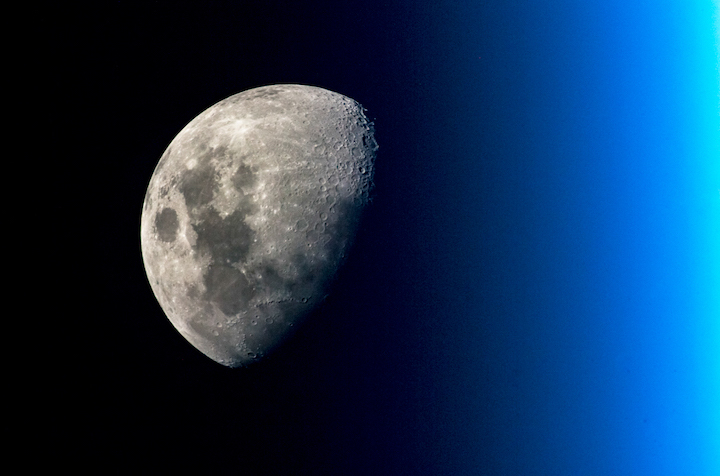23.02.2022
Impending lunar impact heralds future pollution on our natural satellite

The Moon is largely untouched by problems of space junk, but that could change as more companies and countries set their sights on it.© ESA/NASA
On 4 March, a discarded rocket booster will slam into Hertzsprung Crater on the far side of the Moon—humanity’s first known piece of litter to unintentionally reach the lunar surface. Skywatchers originally thought the booster was part of a SpaceX Falcon 9 rocket launched in 2015. But now they say it is part of a Chinese Long March 3C rocket that blasted off in 2014.
The confusion surrounding the booster’s origins illustrates just how hard it is to track space junk in the vicinity of the Moon. With many countries and companies preparing to head to the Moon and beyond in the coming years, researchers are bracing for the problem of lunar pollution to grow. Here’s what they’re doing to prepare.
What is lunar space junk?
There are currently about 23,000 known bits of debris 30 centimeters or larger in orbit around our planet, and up to 100 million fragments 1 millimeter or larger. The U.S. Space Force tracks the larger pieces using radar, but only out to geostationary orbit 58,000 kilometers away from Earth. The Moon is nearly 400,000 kilometers from Earth, and little is known about objects that pass within 70,000 kilometers of its surface, an area known as the “cone of shame,” says Vishnu Reddy, who studies near-Earth objects at the University of Arizona. Low-power radars cannot reach the region, and telescopes have difficulty discerning objects when they fly so close to the bright Moon.
Reddy says there are probably fewer than 200 large pieces of space junk around the Moon, although nobody knows for sure. In the next 5 years, that number could increase significantly, with roughly 50 planned missions from the United States, China, Russia, other countries, and private companies targeting the lunar surface or its orbital space.
What makes lunar space junk unique?
Most fragments that fall out of Earth’s orbit burn up in the atmosphere on re-entry. But the Moon’s lack of an atmosphere means that “there is no re-entry—just smash,” says Jonathan McDowell, an astrophysicist at the Harvard-Smithsonian Center for Astrophysics who maintains catalogs of artificial space objects.
Lunar impacts kick up dust, which is made of microscopic shards of abrasive volcanic glass; in the Apollo era of the 1960s and ’70s, such dust caused countless problems for vehicles, instruments, and crew. The Moon’s low gravity means dust can travel a long way, even to distant exploration sites and potential future crewed bases.
The complex gravitational dance between Earth, the Moon, and the Sun makes tracking lunar space junk hard. Objects can spiral through chaotic and difficult-to-predict pathways as they get tugged by the Moon or Earth. “A small difference in the approach direction makes a large difference in where it ends up,” McDowell says.
What can be done about it?
The U.S. Air Force Research Laboratory last week awarded Reddy and his colleagues $7.5 million to come up with better ways to track lunar space junk. His students have built a small, 61-centimeter telescope to search for distant debris, and they are developing algorithms that can distinguish reflective artificial specks from the harsh glare of the Moon. “It’s like trying to find a tiny firefly next to a giant floodlight,” Reddy says.
Besides simply knowing what’s out there, a catalog that identifies the origin of each piece of space debris is important for determining liability in case something goes wrong. “What if you set up your incredibly expensive lunar installation and a rocket falls on top of it?” asks Alice Gorman, a space archeologist at Flinders University. According to international space law, the party that launched an object is responsible for any damage incurred by its activity, even if it no longer under their control.
But really, what’s going on with this Chinese rocket?
China’s space agency in 2014 launched an experimental spacecraft that looped behind the Moon and returned to Earth to test atmospheric re-entry capabilities for 2020’s Chang’e-5 lunar sample return mission. The mission, called Chang’e-5-T1, carried a secondary payload of scientific instruments in the upper stage of the Long March rocket on behalf of the Luxembourg-based company LuxSpace.
In January, Bill Gray, an independent astronomer, first reported the Moon-bound object—designated WE0913A. At first, he identified it as a SpaceX rocket that had launched the National Oceanic and Atmospheric Administration’s Deep Space Climate Observatory in 2015. But further observations, along with location and speed data from LuxSpace, suggested a different answer. By comparing details of the object’s color against samples of white paint used by different space companies and agencies, Reddy’s team reported last week that WE0913A is probably a Chinese rocket.
China’s Ministry of Foreign Affairs Spokesperson Wang Wenbin this week denied the object is Chinese, saying the booster had burned up in Earth’s atmosphere. (It wasn’t clear whether Wang was referring to Chang’e-5 or Chang’e-5-T1.) U.S. Space Force data suggest a fiery re-entry about 1 year after the 2014 launch, but Daniel Adamo, an astrodynamicist working with McDowell, says this is only an estimate based on the rocket’s initial launch trajectory. The Chinese booster remains the best candidate for the upcoming lunar impactor, he adds.
An official catalog—or the results from Reddy’s surveillance program—could help clear up future problems with space junk beyond Earth, McDowell says. “Starting to think about the lunar environment before there is an environmental problem would be a first for humans—but maybe would not be such a bad idea.”
Quelle: AAAS
